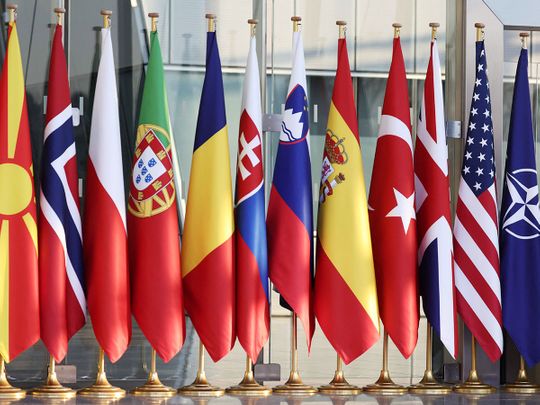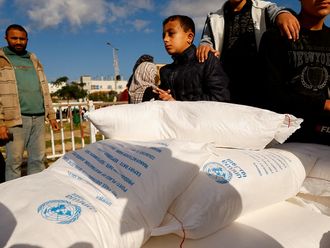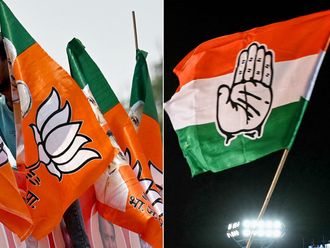
The western discourse on the circumstances behind the creation of the North Atlantic Treaty Organization (Nato), 75 years ago, is hardly convincing.
Yet, that oversimplified discourse must be examined in order for the current decline of the organisation to be appreciated beyond the self-serving politics of Nato’s members.
The history records page of the US State Department speaks of the invention of Nato in a language suitable for a US high school history book.
“After the destruction of the Second World War, the nations of Europe struggled to rebuild their economies and ensure their security,” it reads, which compelled the US to take action: “(integrating) Europe as vital to the prevention of communist expansion across the continent.”
This is the typical logic of Nato’s early doctrine. It can be gleaned from most of the statements made by Western countries that established and continue to dominate the organisation.
The language oscillates between a friendly discourse — for example, Harry Truman’s reference to Nato as a ‘neighbourly act’ — and a threatening one, also Truman’s tough language against “those who might foster the criminal idea of having recourse to war.”
The reality, however, remains vastly different.
Indeed, the US did emerge much stronger, militarily and economically after WWII. That was reflected in the Marshall Plan, an ‘Economic Recovery Plan’, which was a strategic, not a charitable act. It engineered the economic recovery of selected countries who would become the US’ global allies for decades to come.
Upon its establishment, then Canadian Secretary of State Lester Pearson referred to the Nato ‘community’ as part of the ‘world community’, linking the strength of the former to “preserving the peace” for the latter.
As innocuous as such language may seem, it introduced a paternal relationship between the US-dominated Nato and the rest of the world. Thus, it allowed the powerful members of the organisation to define, on behalf of the rest of the world — and often outside the umbrella of the United Nations — such notions as ‘peace’, ‘security’, ‘threat’, and, ultimately, ‘terrorism’.
A case in point is that the first major conflict instigated by Nato did not target external threats to Europe or US territories, but took place thousands of miles away, on the Korean Peninsula.
The west’s political discourse wanted to view the civil war in the Peninsula, before Nato’s intervention as an example of “communist aggression”. This ‘aggression’ supposedly forced Nato’s hands to react. Needless to say, the Korean War (1950-53) was a destructive one.
State of non-peace
The 75 years since then proved the flimsiness of that argument. The Soviet Union has long been dismantled, and North Korea has been desperately fighting to break out of its isolation. Yet, a fractious state of no war-no peace remains in place. It could turn into an outright war at any time.
However, what the war has achieved is something entirely different. The constant state of non-peace provides a justification for the permanent US military presence in the region.
Similar outcomes followed most of Nato’s other interventions: Iraq (1991 and 2003), Yugoslavia (1999), Afghanistan (2001), Libya (2011) and so on.
Yet, the ability to start or exacerbate conflicts, and the inability, or perhaps unwillingness to permanently end wars, is not the real crisis at Nato, 75 years after its establishment.
In an article marking the anniversary, UK Secretary of Defence, Grant Shapps wrote in the Daily Telegraph that Nato must accept that it is now in a “pre-war world”.
He lashed out at those Nato members who were “still failing” to meet the minimally required spending on defence, which equals to two per cent of total national GDPs. “We cannot afford to play Russian roulette with our future,” he wrote.
Shapps’ anxieties are often expressed by other top Nato leaders and officials, who are either warning of an imminent war with Russia or criticising each other for the dwindling influence of the once-powerful organisation.
Much of that blame was placed on former US President Donald Trump, who outright threatened to leave Nato during his only term in office.
Trump’s stance was hardly the instigator of the crisis. They were symptoms of growing problems, which have continued for years after Trump’s dramatic exit from the White House.
New global competition
Nato’s crisis can be summarised as this:
First, the geopolitical formations that existed following the collapse of the Soviet Union and its Warsaw Pact no longer exist.
Second, the main aspect of the new global competition cannot be reduced to military terms. Rather, it is economic.
Third, Europe is now largely dependent on energy sources, trade and even technological integration with countries that the US perceives as foes: China, Russia and others.
Therefore, if Europe allows itself to subscribe to the US polarised language on what constitutes enemies and allies it will pay a heavy price, especially as EU economies are already struggling under the weight of continued wars and constant disruption of energy supplies.
Fourth, fixing all of these challenges and more through force is no longer an option. The changing nature of warfare makes traditional war largely ineffectual.
Though the world has greatly changed, Nato remains committed to a political doctrine from a bygone era. And even if the two per cent threshold is met, the problem will not go away.
It is time for Nato to re-examine its 75-year-old legacy, and be courageous enough to change directions altogether — instead of opting for a state of non-peace, actually seeking real peace.
Ramzy Baroud is a journalist, author and editor. He is the author of six books.









